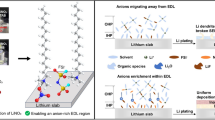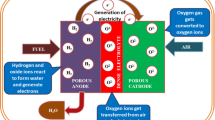Abstract
A novel double dysprosium- and tantalum-doped bismuth oxide electrolyte synthesized by solid-state reaction for low-temperature solid oxide fuel cells (LT-SOFCs) is here reported. The phase structures at room temperature were defined by X-ray powder diffraction (XRD). A stable δ-Bi2O3 phase was obtained by co-doping Bi2O3 with Dy2O3 and Ta2O5 in specific contents. The effect of the co-dopant total content (5–15 mol%) on the ionic conductivity was measured as a function of temperature (300 to 700 °C). Results revealed that the (Dy2O3)13(Ta2O5)2(Bi2O3)85 system showed the highest ionic conductivity as 0.08 S cm−1 at 500 °C, which is three times higher than the binary system reported in the literature (E2O3)20(Bi2O3)80 (20ESB) and in the same range as the ternary system with the highest conductivity reported so far (Dy2O3)8(W2O3)4(Bi2O3)88 (8D4WSB). The lowest activation energy for our system was 0.20 eV at temperatures higher than 550 °C.





Similar content being viewed by others
References
Harwig HA, Gerards AG (1978) Electrical properties of the α, β, γ, and δ phases of bismuth sesquioxide. J Solid State Chem 26(3):265–274. https://doi.org/10.1016/0022-4596(78)90161-5
Zhao Y, Xia C, Jia L, Wang Z, Li H, Yu J, Li Y (2013) Recent progress on solid oxide fuel cell: lowering temperature and utilizing non-hydrogen fuels. Int J Hydrog Energy 38(36):16498–16517. https://doi.org/10.1016/j.ijhydene.2013.07.077
Punn R, Feteira AM, Sinclair DC, Greaves C (2006) Enhanced oxide ion conductivity in stabilized δ-Bi2O3. J Am Chem Soc 128(48):15386–15387. https://doi.org/10.1021/ja065961d
Shuk P, Wiemhöfer HD, Guth U, Göpel W, Greenblatt M (1996) Oxide ion conducting solid electrolytes based on Bi2O3. Solid State Ionics 89(3):179–196. https://doi.org/10.1016/0167-2738(96)00348-7
Boyapati S, Wachsman ED, Jiang N (2001) Effect of oxygen sublattice ordering on interstitial transport mechanism and conductivity activation energies in phase-stabilized cubic bismuth oxides. Solid State Ionics 140(1):149–160. https://doi.org/10.1016/S0167-2738(01)00698-1
Li R, Zhen Q, Drache M, Rubbens A, Estournes C, Vannier R-N (2011) Synthesis and ion conductivity of (Bi2O3)0.75(Dy2O3)0.25 ceramics with grain sizes from the nano to the micro scale. Solid State Ionics 198(1):6–15. https://doi.org/10.1016/j.ssi.2011.05.012
Cucka P, Barrett CS (1962) The crystal structure of Bi and of solid solutions of Pb, Sn, Sb and Te in Bi. Acta Crystallogr 15(9):865–872. https://doi.org/10.1107/S0365110X62002297
Verkerk MJ, Keizer K, Burggraaf AJ (1980) High oxygen ion conduction in sintered oxides of the Bi2O3-Er2O3 system. J Appl Electrochem 10(1):81–90. https://doi.org/10.1007/bf00937342
Kant R, Singh K, Pandey OP (2008) Synthesis and characterization of bismuth vanadate electrolyte material with aluminium doping for SOFC application. Int J Hydrog Energy 33(1):455–462. https://doi.org/10.1016/j.ijhydene.2007.07.025
Verkerk M, Burggraaf A (1981) High oxygen ion conduction in sintered oxides of the Bi2 O 3-Dy2 O 3 system. J Electrochem Soc 128(1):75–82
Takashi S, Rokuro M (1999) Crystal structure and ionic conductivity in Bi 2 O 3 -Rich Bi 2 O 3 –Ta 2 O 5 sintered oxides. Jpn J Appl Phys 38(8R):4838
Tan MY, Tan KB, Zainal Z, Khaw CC, Chen SK (2012) Subsolidus formation and impedance spectroscopy studies of materials in the (Bi2O3)1−x (Y2O3)x binary system. Ceram Int 38(4):3403–3409. https://doi.org/10.1016/j.ceramint.2011.12.052
Polat Y, Dağdemir Y, Arı M (2016) Structural, thermal, electrical and morphological characterization of (Bi2O3)1−x−y(Sm2O3)x(Yb2O3)y nanostructures prepared by solid state synthesis. Curr Appl Phys 16(12):1588–1596. https://doi.org/10.1016/j.cap.2016.09.013
Ermiş İ, Shaikh SPS (2018) Study of crystallographic, thermal and electrical properties of (Bi2O3)1-x-y(Tb4O7)x(Gd2O3)y electrolyte for SOFC application. Ceram Int 44(15):18776–18782. https://doi.org/10.1016/j.ceramint.2018.07.109
Chou T, Liu L-D, Wei W-CJ (2011) Phase stability and electric conductivity of Er2O3–Nb2O5 co-doped Bi2O3 electrolyte. J Eur Ceram Soc 31(16):3087–3094. https://doi.org/10.1016/j.jeurceramsoc.2011.04.016
Bandyopadhyay S, Dutta A (2018) A structural insight into the electrical properties of Dy-Ho co-doped phase stabilized bismuth oxide based electrolytes. J Electroanal Chem 817:55–64. https://doi.org/10.1016/j.jelechem.2018.03.063
Jung DW, Lee KT, Wachsman ED (2016) Dysprosium and gadolinium double doped bismuth oxide electrolytes for low temperature solid oxide fuel cells. J Electrochem Soc 163(5):F411–F415. https://doi.org/10.1149/2.0951605jes
Ermiş İ, Arı M, Acer SD, Dağdemir Y (2015) Phase stability and electric conductivity of Eu 2 O 3 –Tb 4 O 7 co-doped Bi 2 O 3 electrolyte. Int J Hydrog Energy 40(30):9485–9490. https://doi.org/10.1016/j.ijhydene.2015.05.098
Jiang N, Wachsman ED, Jung S-H (2002) A higher conductivity Bi2O3-based electrolyte. Solid State Ionics 150(3):347–353. https://doi.org/10.1016/S0167-2738(02)00291-6
Jung DW, Duncan KL, Wachsman ED (2010) Effect of total dopant concentration and dopant ratio on conductivity of (DyO1.5)x–(WO3)y–(BiO1.5)1−x−y. Acta Mater 58(2):355–363. https://doi.org/10.1016/j.actamat.2009.08.072
Polat Y, Akalan H, Arı M (2017) Thermo-electrical and structural properties of Gd2O3 and Lu2O3 double-doped Bi2O3. Int J Hydrog Energy 42(1):614–622
Jiang N, Wachsman ED (1999) Structural stability and conductivity of phase-stabilized cubic bismuth oxides. J Am Ceram Soc 82(11):3057–3064. https://doi.org/10.1111/j.1151-2916.1999.tb02202.x
Shannon RD, Prewitt CT (1970) Effective ionic radii and crystal chemistry. J Inorg Nucl Chem 32(5):1427–1441. https://doi.org/10.1016/0022-1902(70)80629-7
Rodriguez-Carvajal J (1990) “FULLPROF” program: Rietveld pattern matching analysis of powder patterns. ILL, Grenoble
Lin SE, Wei WCJ (2011) Long-term degradation of Ta2O5-doped Bi2O3 systems. J Eur Ceram Soc 31(16):3081–3086. https://doi.org/10.1016/j.jeurceramsoc.2011.04.015
Yashima M, Ishimura D (2003) Crystal structure and disorder of the fast oxide-ion conductor cubic Bi2O3. Chem Phys Lett 378(3):395–399. https://doi.org/10.1016/j.cplett.2003.07.014
Ersoy E, Cakar S, Yildiz E, Yilmaz S, Turkoglu O, Sarioz O (2015) Fabrication and characterization of dysprosium-doped bismuth oxide films for IT-SOFCs via slurry spin coating technique. Int J Appl Ceram Technol 12(S3):E152–E161. https://doi.org/10.1111/ijac.12387
Wachsman ED, Lee KT (2011) Lowering the temperature of solid oxide fuel cells. Science 334(6058):935–939
Azad AM, Larose S, Akbar SA (1994) Bismuth oxide-based solid electrolytes for fuel cells. J Mater Sci 29(16):4135–4151. https://doi.org/10.1007/bf00414192
Boyapati S, Wachsman ED, Chakoumakos BC (2001) Neutron diffraction study of occupancy and positional order of oxygen ions in phase stabilized cubic bismuth oxides. Solid State Ionics 138(3):293–304. https://doi.org/10.1016/S0167-2738(00)00792-X
Verkerk MJ, van de Velde GMH, Burggraaf AJ, Helmholdt RB (1982) Structure and ionic conductivity of Bi2O3 substituted with lanthanide oxides. J Phys Chem Solids 43(12):1129–1136. https://doi.org/10.1016/0022-3697(82)90141-X
Acknowledgments
This investigation was carried out partially at CIMAV, CINVESTAV, CENAPROT, and LIDTRA laboratories. P.S. Cardenas-Terrazas thanks CONACYT for her scholarship (grant 449746). The authors also thank K. Campos-Venegas, E. Guerrero-Lestarjette, M. Roman-Aguirre, and A. M. Benitez Castro for the shared expertise and technical support.
Author information
Authors and Affiliations
Corresponding authors
Ethics declarations
Conflict of interest
The authors declare that they have no conflict of interest.
Additional information
Publisher’s note
Springer Nature remains neutral with regard to jurisdictional claims in published maps and institutional affiliations.
Rights and permissions
About this article
Cite this article
Cardenas-Terrazas, P.S., Ayala-Ayala, M.T., Muñoz-Saldaña, J. et al. High ionic conductivity dysprosium and tantalum Co-doped bismuth oxide electrolyte for low-temperature SOFCs. Ionics 26, 4579–4586 (2020). https://doi.org/10.1007/s11581-020-03572-y
Received:
Revised:
Accepted:
Published:
Issue Date:
DOI: https://doi.org/10.1007/s11581-020-03572-y




